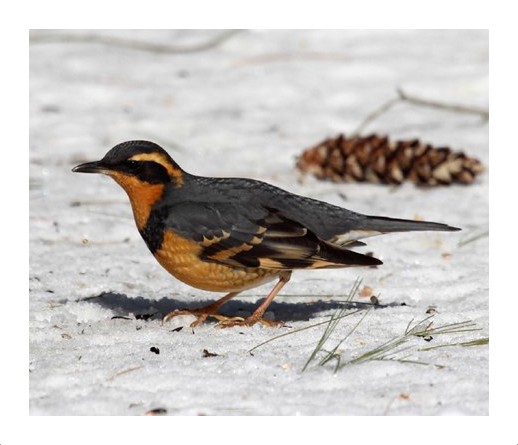The Peregrine Vol 19, No 4, July/Aug & Vol 19, No 5, Sept/Oct 2020
Full-length Article
Report from Frigid Canada - February 2020
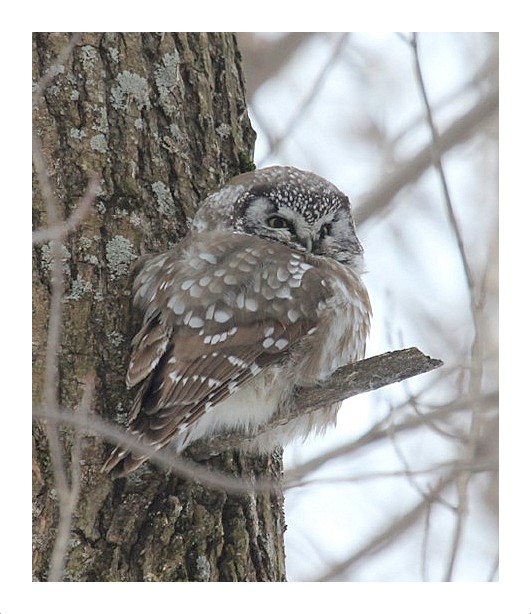
Frigid Canada's Birds Warmed a Pair of Birders
In February, Quebec is cold. Like, really cold! But is it too cold for Pittsburghers to bird? A brief window of mid-February travel time and a staked-out Boreal Owl prompted Adrienne and me to find out.
Before commencing any such trip, as may now be the birding standard, I thoroughly reviewed eBird, checking rarity reports and running my "needs" list through various potential destinations. As often happens, such research yielded a few interesting possibilities. The first was the aforementioned Boreal Owl at Rêserve Naturelle de Pointe-Yamachiche in Quebec. That's far from Pittsburgh, about 10 hours, and one never knows exactly how winter driving conditions will be, but Boreal Owl is one of only four species I have seen in the ABA Area that Adrienne has not. The bird seemed to be pretty regular: When would be our next chance for Boreal Owl?
I figured that if we drove all the way to Montreal first, we could spend a night and try for the Boreal the next day before continuing our journey west through Ontario. Another surprise yielded by pre-trip research was that Ottawa has a small population of Gray Partridges, which I later learned are barely holding on and were once much more common throughout the city. I first got clued into this intel when looking over Mike Fialkovich's Flickr album of photos he had taken just a few weeks prior, and eBird seemed to indicate the birds were often located in a specific area not far west of the city.
The third enticing discovery was a slam dunk: a Varied Thrush regularly coming to a feeder in Haliburton County, Ontario, a little south of Algonquin Provincial Park. Since we had never birded in its breeding range in the Pacific Northwest, it would be a lifer.
For many 3RBC members, and indeed many birders and naturalists, Algonquin Provincial Park is a destination of significant intrigue, each season presenting different appeals and challenges mostly anchored around the excellent accessibility of several boreal specialty birds. It is surprisingly close to Pittsburgh, just a full day's drive if you avoid Toronto traffic and don't experience any delays crossing the border. In August 2017, Adrienne and I visited Jack and Sue Solomon, seasoned Algonquin-enthusiasts, and experienced the place's grandeur, howling with wolves, encountering most of the specialties, and twice happening upon a big bull moose while out on the trails. Algonquin has perhaps an ideal balance between wilderness and convenience. Experiencing Algonquin in winter had a different but strong appeal, and I'd heard winter was the best season to see American martens, which Mike had photographed at the visitor center feeders.
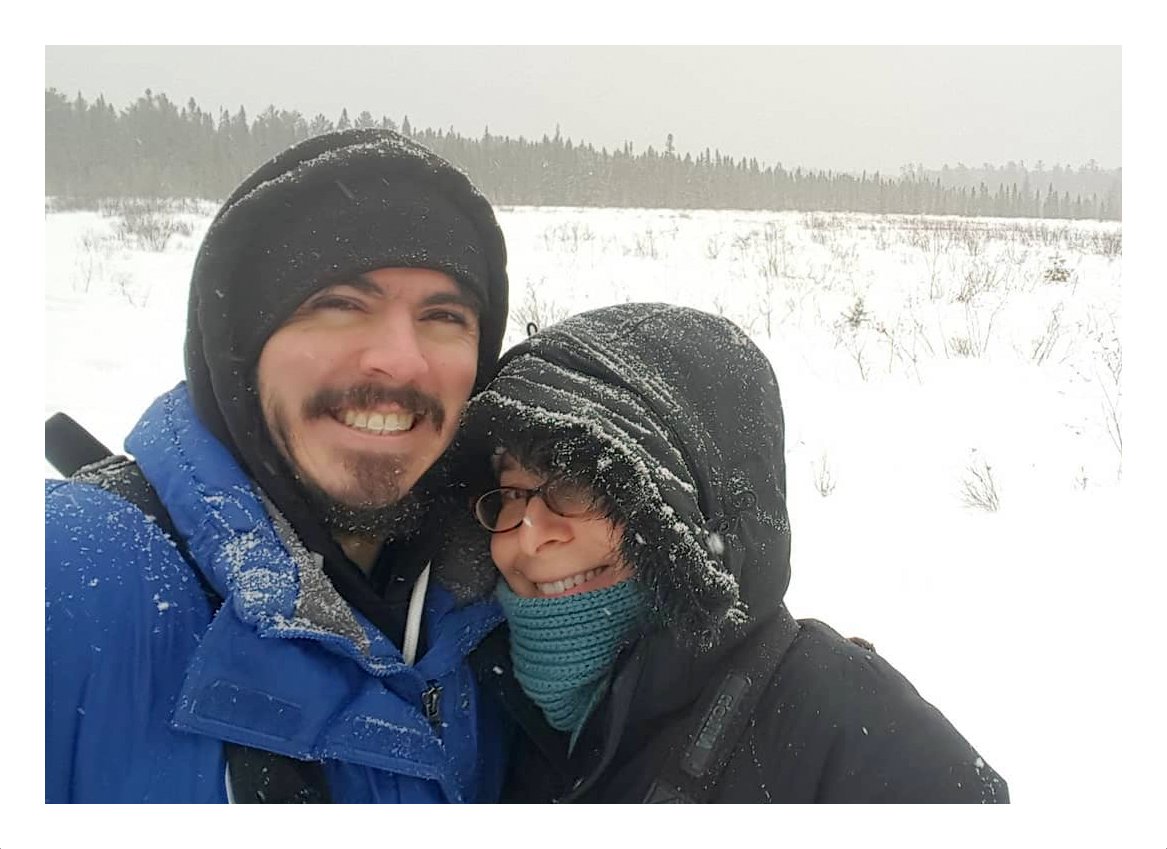
The plan came together, and we embarked on our journey. The first day driving north through New York was bitterly cold, hovering around zero degrees, but three and possibly four Rough-legged Hawks spotted along the highway were good omens. We arrived in Montreal a bit exhausted and cold-weary, and - no rest for the weary - I stayed up judging field notebook entries for the American Birding Association's Young Birder of the Year contest. But the prospect of the Boreal and other winter delights the next morning launched us even farther northeast, a good way into this province where we'd never been before.
While researching the Boreal and trying to find the best notes for its likely whereabouts, I'd run into what was, but shouldn't have been, a surprising issue: Nearly every checklist's annotations were in French! I'd done my best with Google translator and asking Adrienne for help, as she speaks French, but all I knew was the bird was "across the river" and not far from an also frequently-seen Northern Saw-whet Owl.
When we arrived, we saw cars lined up but no clear trail to head down. We drove back to the cars and saw someone walking with an enormous camera. I asked, "Have you seen any owls?"
The look of shock and consternation I was greeted with was not what I had expected, but the issue became immediately obvious: this Quêbêcois was simply not expecting to be spoken to in English. I quickly asked Adrienne how to say 'owl' in French, then turned back and asked, chouette?
Then we understood each other, and Adrienne ably continued the exchange, which eventually resulted in this kind and accommodating photographer taking us to the start of the trail and setting us down the right path. "Bon chance!" she said.
Within a few seconds, I saw a bird flitting along the trail. Once I had it in my bins, I realized to my delight that it was a Snow Bunting. The path entered the forest and passed a sign admonishing visitors to respect owls. We soon met other Quêbêcois birders who offered to take us to the Boreal. Bon chance! indeed, as it became obvious we needed to cross a frozen river to see the bird which we probably wouldn't have figured out or risked.
But soon enough, we were staring at Adrienne's lifer Boreal Owl and only my second ever, the first being a 2005 encounter on Amherst Island.
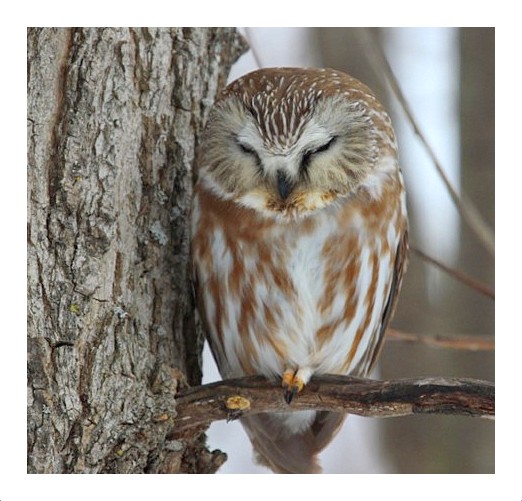
Almost before I could finish, she replied, "Boreal!" with the kind of energy that meant she was a through-and-true birder. So, we doubled back and got her on the bird, which was her first encounter with a Boreal not at a banding station, and then we looped around for the saw-whet. We learned that Sarah was a graduate student studying mercury poisoning in Indonesian birds and had travelled all over the world.
"Do you guys know about the Northern Hawk Owl?" she asked. "It's only about 25 minutes from here." Our adventure with Sarah continued, and after a refueling stop at a gas station, we were off to search for our newest quarry. Of perhaps some amusement to 3RBC members, on the way to this new spot, we passed by the fairly large city (population 137,000) of Trois-Rivières, or Three Rivers! I of course checked later to see if Trois-Rivières had a bird club and they do: Club d'ornithologie de Trois-Rivières. So, there is also a Three Rivers Birding Club in Quebec!
At Parc êcologique de l'Anse du Port, we made our way down the boardwalk in the frigid cold, occasionally stopping to enjoy the White-breasted Nuthatches and Black-capped Chickadees at extremely close range as they ate along rails strewn with sunflower seeds. When we reached the end of the boardwalk with no sign of the Northern Hawk Owl and only the windy St. Lawrence River (one of the three rivers) before us, we backtracked and noticed some steps that led off the boardwalk and into a snow path. Soon we encountered a couple Quêbêcois trudging toward us from their recent owl-encounter, and then we had it, an inquisitive, high-perched Northern Hawk Owl, my first lifer of the trip and my last remaining northern owl species. After bidding farewell to our owl squad-mate Sarah, we continued to Ottawa.
With a full day to bird in the Canadian capital city, we focused our efforts on finding Gray Partridges, an introduced species which we learned was once widespread throughout the area but is now barely hanging on in one not-so-reliable spot. We tried in both the morning and the afternoon, driving slowly and scanning carefully, at times joined by a local birder, trying to make each gray rock and smudge into a Gray Partridge but never quite pulling off the feat. In the late afternoon, we went to meet a Canadian friend to enjoy yet another Northern Hawk Owl (new for my Ontario list!), which we quickly found. We then went to a spot with dozens of Snow Buntings and a dramatically posed Snowy Owl, a Canadian flag waving in the distance behind it. Before departing the region the next day, we checked for the Gray Partridge again. This time, five gray blobs with red heads were ambling along the snow fields.
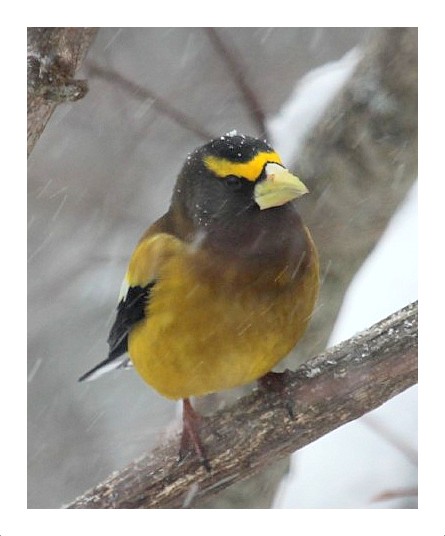
When we visited Algonquin in 2017, we stayed on the west side of the park in Dwight, but as we were coming from the east, we stayed in Whitney. This is slightly farther from Pittsburgh, but conveniently stationed us much closer to the visitor center. The next day, the park was glorious: a nice big flock of at least 19 Evening Grosbeaks paid a morning visit to the visitor center feeders. Seeing them had been one of our goals, and our early arrival was also rewarded by the presence of a Ruffed Grouse, which soon disappeared beneath the spruce trees. Both of those were new Canadian encounters for me, as were the Pine Siskins that popped in that morning.
We also saw good numbers of both crossbill species, which were scattered throughout the park and especially along the main highway. It wasn't a priority, but we got skunked on all the boreal specialties. We walked the Spruce Bog Trail twice and found next to nothing besides an exceptionally large Common Raven, despite my looking carefully for a Spruce Grouse. The day, while not cold for the area (around 20° F), was a little on the yucky side with nasty sleet coming down, which might have been a factor in missing this grouse. With more time, I would've liked to go someplace deeper into the habitat that we weren't able to visit. Eventually we just ran out of daylight. No American marten for us either, so we'll have to try again!
Sometimes observations of common birds can unexpectedly be the most noteworthy event of a birding trip. So it was here: I was astonished by the sheer number of Blue Jays throughout the park and especially at the visitor center. They were absolutely everywhere and the most common or most conspicuous bird in the park. There were conservatively 65 around the visitor center, and our day's total surely exceeded 100 individual Blue Jays.
The next day, we needed to return to Pittsburgh, but on the way, we tried for one more bird: the staked out Varied Thrush,
